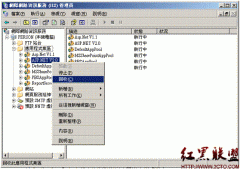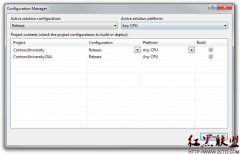浅谈ASP.NET的Postback 实例代码第1/2页
来源:不详 责任编辑:admin 发表时间:2013-07-02 03:00 点击:次
我们知道,无论是ASP.NET1.x,2.0,甚至是以后的版本,ASP.NET最终Render到Client端通过浏览器浏览的都是一样:一个单纯的HTML。Client通过Submit Form的方式将填入Form的数据提交给Server进行处理。我们现在来看看ASP.NET整个Postback程序处理的过程。
首先我们通过一个Sample来看ASP.NET如何处理一个通过Click一个Button引起的Postback。下面是Web Page的HTML:
<%@ Page Language="C#" AutoEventWireup="true" CodeFile="Default.aspx.cs" Inherits="_Default" %>
<!DOCTYPE html PUBLIC "-//W3C//DTD XHTML 1.0 Transitional//EN" "http://www.w3.org/TR/xhtml1/DTD/xhtml1-transitional.dtd">
<html xmlns="http://www.w3.org/1999/xhtml">
<head runat="server">
<title>Test Page</title>
</head>
<body>
<form id="form1" runat="server">
<div>
<asp:Label runat="server" ID="LabelMessage" ForeColor="red"></asp:Label>
</div>
<div>
<asp:Button runat="server" ID="Button1" Text="Button1" OnClick="Button1_Click" OnCommand="Button_Command" CommandArgument="Button1" />
<asp:Button runat="server" ID="Button2" Text="Button2" OnClick="Button2_Click" OnCommand="Button_Command" CommandArgument="Button2" UseSubmitBehavior="false" />
<asp:Button runat="server" ID="Button3" Text="Button3" OnClick="Button3_Click" OnCommand="Button_Command" CommandArgument="Button3" UseSubmitBehavior="false" />
</div>
</form>
</body>
</html>
很简单,定义了3个Button,分别注册了他们的两个Event:Click和Command。3个Button的Command Event Hander是一样的:Button_Command,通过指定的CommandArgument来让Event Handler判断到底是哪个Button触发了Command Event。
下面是Code Behind:
using System;
using System.Data;
using System.Configuration;
using System.Web;
using System.Web.Security;
using System.Web.UI;
using System.Web.UI.WebControls;
using System.Web.UI.WebControls.WebParts;
using System.Web.UI.HtmlControls;
public partial class _Default : System.Web.UI.Page
{
protected void Page_Load(object sender, EventArgs e)
{
}
protected void Button1_Click(object sender, EventArgs e)
{
string message = string.Format("The {0} event of {1} is fired", "Click", "Button1");
this.LabelMessage.Text = message;
}
protected void Button2_Click(object sender, EventArgs e)
{
string message = string.Format("The {0} event of {1} is fired", "Click", "Button2");
this.LabelMessage.Text = message;
}
protected void Button3_Click(object sender, EventArgs e)
{
string message = string.Format("The {0} event of {1} is fired", "Click", "Button3");
this.LabelMessage.Text = message;
}
protected void Button_Command(object sender, CommandEventArgs e)
{
string message = string.Format("The {0} event of {1} is fired", "Command", e.CommandArgument);
this.LabelMessage.Text += "; " + message;
}
}
我们来运行这个Page,并Click某个按钮(比如Button2):

我们通过最上方的Message可以看出,Button2的Click Event和Command先后触发。
这篇Blog的主旨就是从方法调用的角度讲述整个程序运行的过程:从HTML 被Render到Client端,到用户Click某个按钮,输入被Postback到Server端,并触发两个Event,执行Event Handler打印出相关的Message。
首先我们来看看ASP.NET设计的Page Render到Client端的HTML是什么样子:
<!DOCTYPE html PUBLIC "-//W3C//DTD XHTML 1.0 Transitional//EN" "http://www.w3.org/TR/xhtml1/DTD/xhtml1-transitional.dtd">
&
首先我们通过一个Sample来看ASP.NET如何处理一个通过Click一个Button引起的Postback。下面是Web Page的HTML:
复制代码 代码如下:
<%@ Page Language="C#" AutoEventWireup="true" CodeFile="Default.aspx.cs" Inherits="_Default" %>
<!DOCTYPE html PUBLIC "-//W3C//DTD XHTML 1.0 Transitional//EN" "http://www.w3.org/TR/xhtml1/DTD/xhtml1-transitional.dtd">
<html xmlns="http://www.w3.org/1999/xhtml">
<head runat="server">
<title>Test Page</title>
</head>
<body>
<form id="form1" runat="server">
<div>
<asp:Label runat="server" ID="LabelMessage" ForeColor="red"></asp:Label>
</div>
<div>
<asp:Button runat="server" ID="Button1" Text="Button1" OnClick="Button1_Click" OnCommand="Button_Command" CommandArgument="Button1" />
<asp:Button runat="server" ID="Button2" Text="Button2" OnClick="Button2_Click" OnCommand="Button_Command" CommandArgument="Button2" UseSubmitBehavior="false" />
<asp:Button runat="server" ID="Button3" Text="Button3" OnClick="Button3_Click" OnCommand="Button_Command" CommandArgument="Button3" UseSubmitBehavior="false" />
</div>
</form>
</body>
</html>
很简单,定义了3个Button,分别注册了他们的两个Event:Click和Command。3个Button的Command Event Hander是一样的:Button_Command,通过指定的CommandArgument来让Event Handler判断到底是哪个Button触发了Command Event。
下面是Code Behind:
复制代码 代码如下:
using System;
using System.Data;
using System.Configuration;
using System.Web;
using System.Web.Security;
using System.Web.UI;
using System.Web.UI.WebControls;
using System.Web.UI.WebControls.WebParts;
using System.Web.UI.HtmlControls;
public partial class _Default : System.Web.UI.Page
{
protected void Page_Load(object sender, EventArgs e)
{
}
protected void Button1_Click(object sender, EventArgs e)
{
string message = string.Format("The {0} event of {1} is fired", "Click", "Button1");
this.LabelMessage.Text = message;
}
protected void Button2_Click(object sender, EventArgs e)
{
string message = string.Format("The {0} event of {1} is fired", "Click", "Button2");
this.LabelMessage.Text = message;
}
protected void Button3_Click(object sender, EventArgs e)
{
string message = string.Format("The {0} event of {1} is fired", "Click", "Button3");
this.LabelMessage.Text = message;
}
protected void Button_Command(object sender, CommandEventArgs e)
{
string message = string.Format("The {0} event of {1} is fired", "Command", e.CommandArgument);
this.LabelMessage.Text += "; " + message;
}
}
我们来运行这个Page,并Click某个按钮(比如Button2):

我们通过最上方的Message可以看出,Button2的Click Event和Command先后触发。
这篇Blog的主旨就是从方法调用的角度讲述整个程序运行的过程:从HTML 被Render到Client端,到用户Click某个按钮,输入被Postback到Server端,并触发两个Event,执行Event Handler打印出相关的Message。
首先我们来看看ASP.NET设计的Page Render到Client端的HTML是什么样子:
复制代码 代码如下:
<!DOCTYPE html PUBLIC "-//W3C//DTD XHTML 1.0 Transitional//EN" "http://www.w3.org/TR/xhtml1/DTD/xhtml1-transitional.dtd">
&
相关新闻>>
最新推荐更多>>>
- 发表评论
-
- 最新评论 进入详细评论页>>



